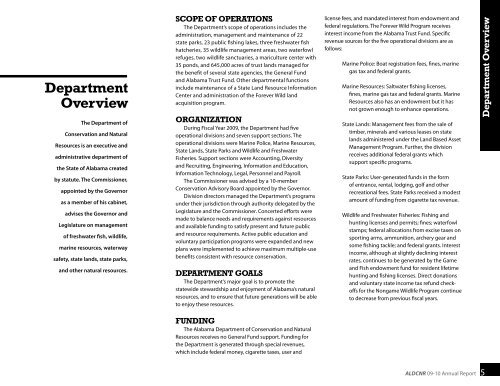2009-2010 Annual Report - Alabama Department of Conservation ...
2009-2010 Annual Report - Alabama Department of Conservation ...
2009-2010 Annual Report - Alabama Department of Conservation ...
Create successful ePaper yourself
Turn your PDF publications into a flip-book with our unique Google optimized e-Paper software.
<strong>Department</strong><br />
Overview<br />
The <strong>Department</strong> <strong>of</strong><br />
<strong>Conservation</strong> and Natural<br />
Resources is an executive and<br />
administrative department <strong>of</strong><br />
the State <strong>of</strong> <strong>Alabama</strong> created<br />
by statute. The Commissioner,<br />
appointed by the Governor<br />
as a member <strong>of</strong> his cabinet,<br />
advises the Governor and<br />
Legislature on management<br />
<strong>of</strong> freshwater fish, wildlife,<br />
marine resources, waterway<br />
safety, state lands, state parks,<br />
and other natural resources.<br />
Scope <strong>of</strong> Operations<br />
The <strong>Department</strong>’s scope <strong>of</strong> operations includes the<br />
administration, management and maintenance <strong>of</strong> 22<br />
state parks, 23 public fishing lakes, three freshwater fish<br />
hatcheries, 35 wildlife management areas, two waterfowl<br />
refuges, two wildlife sanctuaries, a mariculture center with<br />
35 ponds, and 645,000 acres <strong>of</strong> trust lands managed for<br />
the benefit <strong>of</strong> several state agencies, the General Fund<br />
and <strong>Alabama</strong> Trust Fund. Other departmental functions<br />
include maintenance <strong>of</strong> a State Land Resource Information<br />
Center and administration <strong>of</strong> the Forever Wild land<br />
acquisition program.<br />
Organization<br />
During Fiscal Year <strong>2009</strong>, the <strong>Department</strong> had five<br />
operational divisions and seven support sections. The<br />
operational divisions were Marine Police, Marine Resources,<br />
State Lands, State Parks and Wildlife and Freshwater<br />
Fisheries. Support sections were Accounting, Diversity<br />
and Recruiting, Engineering, Information and Education,<br />
Information Technology, Legal, Personnel and Payroll.<br />
The Commissioner was advised by a 10-member<br />
<strong>Conservation</strong> Advisory Board appointed by the Governor.<br />
Division directors managed the <strong>Department</strong>’s programs<br />
under their jurisdiction through authority delegated by the<br />
Legislature and the Commissioner. Concerted efforts were<br />
made to balance needs and requirements against resources<br />
and available funding to satisfy present and future public<br />
and resource requirements. Active public education and<br />
voluntary participation programs were expanded and new<br />
plans were implemented to achieve maximum multiple-use<br />
benefits consistent with resource conservation.<br />
<strong>Department</strong> Goals<br />
The <strong>Department</strong>’s major goal is to promote the<br />
statewide stewardship and enjoyment <strong>of</strong> <strong>Alabama</strong>’s natural<br />
resources, and to ensure that future generations will be able<br />
to enjoy these resources.<br />
license fees, and mandated interest from endowment and<br />
federal regulations. The Forever Wild Program receives<br />
interest income from the <strong>Alabama</strong> Trust Fund. Specific<br />
revenue sources for the five operational divisions are as<br />
follows:<br />
Marine Police: Boat registration fees, fines, marine<br />
gas tax and federal grants.<br />
Marine Resources: Saltwater fishing licenses,<br />
fines, marine gas tax and federal grants. Marine<br />
Resources also has an endowment but it has<br />
not grown enough to enhance operations.<br />
State Lands: Management fees from the sale <strong>of</strong><br />
timber, minerals and various leases on state<br />
lands administered under the Land Based Asset<br />
Management Program. Further, the division<br />
receives additional federal grants which<br />
support specific programs.<br />
State Parks: User-generated funds in the form<br />
<strong>of</strong> entrance, rental, lodging, golf and other<br />
recreational fees. State Parks received a modest<br />
amount <strong>of</strong> funding from cigarette tax revenue.<br />
Wildlife and Freshwater Fisheries: Fishing and<br />
hunting licenses and permits; fines; waterfowl<br />
stamps; federal allocations from excise taxes on<br />
sporting arms, ammunition, archery gear and<br />
some fishing tackle; and federal grants. Interest<br />
income, although at slightly declining interest<br />
rates, continues to be generated by the Game<br />
and Fish endowment fund for resident lifetime<br />
hunting and fishing licenses. Direct donations<br />
and voluntary state income tax refund check<strong>of</strong>fs<br />
for the Nongame Wildlife Program continue<br />
to decrease from previous fiscal years.<br />
<strong>Department</strong> Overview<br />
Funding<br />
The <strong>Alabama</strong> <strong>Department</strong> <strong>of</strong> <strong>Conservation</strong> and Natural<br />
Resources receives no General Fund support. Funding for<br />
the <strong>Department</strong> is generated through special revenues,<br />
which include federal money, cigarette taxes, user and<br />
ALDCNR 09-10 <strong>Annual</strong> <strong>Report</strong> 5
















